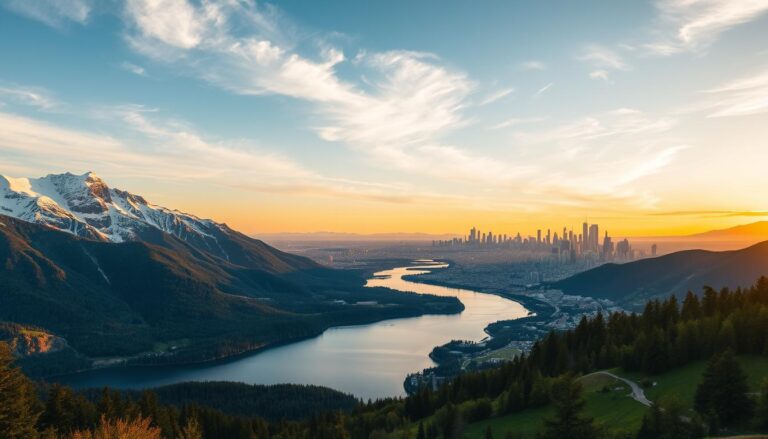Sustainable Travel Tips for Eco-Conscious Tourists: Travel Green
Exploring the world doesn’t have to come at the expense of the planet. Making mindful choices while traveling can significantly reduce your carbon footprint and support local culture. From packing lighter to choosing low-impact transport, small changes can lead to big results.
Did you know that air travel accounts for 20% of the tourism industry’s carbon emissions1? Opting for trains, which emit 55-75% less carbon, can make a huge difference1. Additionally, reducing baggage weight lowers fuel consumption, benefiting both the environment and your wallet.
Eco-friendly tourism isn’t just about reducing emissions—it’s about preserving the beauty and resources of the destinations we love. By choosing accommodations that prioritize energy efficiency, you can contribute to a healthier planet. Let’s explore how you can make your next trip more sustainable and impactful.
Key Takeaways
- Traveling light reduces fuel consumption and emissions.
- Trains are a low-carbon alternative to air travel.
- Choosing eco-friendly accommodations supports sustainability.
- Small changes can have a big impact on the environment.
- Mindful travel helps preserve local culture and resources.
Understanding the Environmental Impact of Travel
Traveling the globe leaves a lasting mark, but understanding its environmental impact can help us make better choices. From rising carbon emissions to biodiversity loss, the way we explore the world has far-reaching consequences. Let’s dive into the key challenges and how we can address them.
The Climate Crisis and Rising Carbon Emissions
Modern travel contributes significantly to the climate crisis. Tourism accounts for 8-10% of greenhouse gas emissions worldwide2. Transportation, especially flights, plays a major role in this. For example, flying can produce up to three times more emissions than traveling by train for the same distance3.
These emissions not only accelerate global warming but also affect air quality, leading to long-term health issues like cancer2. By choosing low-emission transportation options, we can reduce our carbon footprint and protect the planet.
Biodiversity Loss and the Effects on Local Ecosystems
Travel also impacts local ecosystems and biodiversity. Over-tourism can lead to a decline in biodiversity by up to 30% in heavily visited areas3. This loss affects not only wildlife but also the local community that depends on these ecosystems for resources like water and food.
For instance, pollution from tourism can harm marine life and disrupt natural habitats. Supporting conservation efforts, such as tree planting, can offset some of these effects—each tree planted can absorb approximately 1 ton of CO2 over its lifetime3.
| Activity | Environmental Impact | Solution |
|---|---|---|
| Flying | High carbon emissions | Opt for trains or buses |
| Over-tourism | Biodiversity loss | Visit off-peak seasons |
| Waste generation | Pollution and resource depletion | Use reusable items |
By making mindful choices—like staying at eco-certified hotels and consuming local food—we can minimize our environmental impact. These practices not only support sustainability but also ensure that up to 70% of tourism revenue stays within the local community3.
Sustainable travel tips for eco-conscious tourists

Small changes in how we pack and move can make a big difference for the planet. By adopting mindful habits, you can reduce your environmental footprint while enjoying a smoother trip. Let’s explore how the Three Rs—Reduce, Reuse, Recycle—can transform your packing routine and transportation choices.
Practical Packing and the Three Rs Approach
Packing light isn’t just about convenience—it’s about reducing your impact. Start by minimizing plastic and single-use items. Instead of disposable water bottles, bring a reusable one. Swap out plastic shopping bags for a foldable, eco-friendly alternative. These simple swaps cut down on waste and save resources.
Here’s how to pack smarter:
- Choose compact, multi-purpose items like reusable cutlery.
- Opt for lightweight, eco-friendly toiletries.
- Plan outfits to avoid overpacking.
These steps not only lighten your load but also reduce fuel consumption during transport4.
Eco-Friendly Transportation Options and Low-Impact Modes
Transportation plays a huge role in your journey’s environmental impact. Trains, for example, emit 55-75% less carbon than flights4. For shorter distances, consider biking or walking. These options not only reduce emissions but also let you experience your destination more intimately.
Here’s a quick comparison:
| Mode | Carbon Impact |
|---|---|
| Train | Low |
| Bike | Minimal |
| Flight | High |
By choosing low-impact transport, you’re taking a step toward a greener future.
Remember, every choice counts. Whether it’s packing a reusable water bottle or hopping on a train, these small changes add up. Together, we can protect the planet while exploring its beauty.
Choosing Eco-Friendly Accommodations and Experiences
Your choice of where to stay can shape the future of the places you visit. From green hotels to eco-lodges, the right accommodation can reduce your carbon footprint and support local economies. By opting for certified eco-friendly options, you’re not just booking a room—you’re making a positive impact.
Green Hotels, Eco-Lodges, and Certification Filters
Eco-friendly accommodations like green hotels and eco-lodges are designed to minimize environmental harm. Many use renewable energy, reduce waste, and conserve water. For example, eco-friendly hotels report a 30% reduction in energy consumption when utilizing renewable sources5.
Certification filters on platforms like Airbnb and fairbnb.coop make it easy to identify these options. Look for certifications like LEED or Green Key to ensure your stay aligns with sustainability goals. These certifications often indicate practices like energy efficiency, waste reduction, and resource conservation.
Here’s a quick guide to eco-certifications:
| Certification | Focus Area |
|---|---|
| LEED | Energy efficiency and sustainable design |
| Green Key | Environmental management and guest engagement |
| EarthCheck | Resource conservation and community support |
Supporting Local Cuisine and Community-Based Tourism
Choosing to support local businesses can transform your trip into a meaningful experience. Local restaurants that source ingredients nearby not only offer fresh, authentic meals but also foster community growth. In fact, 50% of travelers prefer locally-owned restaurants, which helps sustain local economies5.
Community-based tourism initiatives, like those in Costa Rica and Bhutan, combine environmental care with cultural preservation. By participating, you’re directly contributing to the well-being of the places you visit.
“Travel is about more than seeing new places—it’s about leaving them better than you found them.”
By choosing eco-friendly accommodations and supporting local businesses, you’re not just traveling—you’re making a difference. Every decision counts, and together, we can protect the planet while exploring its beauty.
Smart Strategies for Reducing Waste and Conserving Resources

Every journey leaves a mark, but with mindful choices, we can ensure it’s a positive one. Reducing waste and conserving resources are key to minimizing your footprint while exploring the world. Let’s dive into practical ways to make a difference.
Minimizing Single-Use Plastics and Waste Generation
Single-use plastics, like straws and bags, are major contributors to pollution, especially in marine environments. Sea turtles often mistake plastic bags for jellyfish, leading to digestive issues or death6. By avoiding these items, you can help protect fragile ecosystems.
Here are some simple swaps to reduce waste:
- Carry a reusable water bottle to eliminate the need for hundreds of single-use plastic bottles7.
- Use a foldable shopping bag instead of plastic bags.
- Opt for reusable cutlery and containers when dining out.
These small changes can significantly lower your carbon emission and contribute to cleaner destinations.
Resource Conservation: Water, Energy, and Recycling Methods
Conserving resources like water and energy is another effective practice. Hotels adopting eco-friendly initiatives, such as water-saving fixtures and energy-efficient lighting, report a 30% reduction in energy consumption7.
Here’s how you can conserve resources during your trip:
- Reuse towels and linens to reduce water usage.
- Turn off lights and unplug devices when not in use.
- Participate in recycling programs offered by accommodations.
By adopting these habits, you’re not just reducing waste—you’re supporting conservation efforts that benefit the planet and local communities.
“Every small action adds up. Together, we can create a cleaner, healthier world.”
From avoiding single-use plastics to conserving water and energy, these strategies are easy to implement. They not only reduce your footprint but also set an example for others to follow. Let’s make every journey a step toward a greener future.
Navigating Transportation for a Lower Carbon Footprint

Transportation choices are a key factor in reducing our environmental footprint. Whether you’re planning a weekend getaway or a cross-country adventure, how you move matters. By opting for greener options, you can cut emissions and make your trip more planet-friendly.
Opting for Trains, Buses, and Biking for Shorter Distances
For shorter distances, trains and buses are excellent alternatives to high-emission flights. Trains emit 55-75% less carbon than airplanes, making them a smarter choice for the environment8. Biking or walking is even better—these options produce zero emissions and let you enjoy the journey up close.
Here’s a quick comparison of transportation modes:
| Mode | Carbon Impact |
|---|---|
| Train | Low |
| Bus | Moderate |
| Bike | Minimal |
Choosing these options not only reduces your carbon footprint but also saves fuel and energy. For example, a petrol car journey emits four times more CO2e than a coach trip for the same distance8.
When Flying is Necessary: Offsetting Emissions and Smart Scheduling
Sometimes, flying is unavoidable. When it is, consider offsetting your emissions. Programs like reforestation or renewable energy projects can balance out your activity’s impact8. Many airlines now offer carbon offset tools during booking—take advantage of them.
Smart scheduling can also help. Opt for direct flights to reduce fuel consumption, and pack light to lower the plane’s weight. Every small step adds up to a bigger impact.
“The way we travel today shapes the world we’ll see tomorrow.”
By combining low-impact modes and offsetting when necessary, you can make your trip both enjoyable and eco-friendly. Whether it’s carrying a reusable bag or choosing a train over a plane, every decision counts.
Conclusion
Every trip offers a chance to make a positive impact on the world. By making thoughtful choices, you can reduce your footprint and support local communities. From selecting low-emission transport to staying at eco-certified accommodations, small steps lead to big changes9.
Supporting local businesses and conserving resources not only benefits the economy but also preserves the beauty of each destination. Whether it’s choosing a train over a flight or packing reusable items, every action counts10.
Let’s continue exploring ways to make our journeys more eco-friendly. Share these practices with others and inspire a greener future. Together, we can protect the world while enjoying its wonders.
FAQ
How can I reduce my carbon footprint while traveling?
What are some ways to minimize waste during my trip?
How can I support local communities while traveling?
What should I look for in eco-friendly accommodations?
Are there ways to conserve resources while on the road?
How can I make my transportation choices more sustainable?
What are the benefits of choosing local cuisine?
Source Links
- 50 Green Tips for Travelling in 2025 | GreenMatch
- World Tourism Day 2024: Exploring Sustainable Tourism
- How to Travel Sustainably: A Guide for Eco-Conscious Explorers
- How to Be an Eco-Conscious Traveler: Sustainable Travel Tips & Tricks – ECOS®
- Embrace Sustainable Travel: Tips For Eco-Friendly Adventures
- Plastic-Free Travel: Tips to Reduce Waste on Your Next Trip
- Essential Sustainable Travel Tips for Eco-Conscious Explorers
- Navigating Sustainable Travel
- 10 Sustainable Travel Tips — Sustainable Review
- Eco-responsible travel: our guide for 2025







